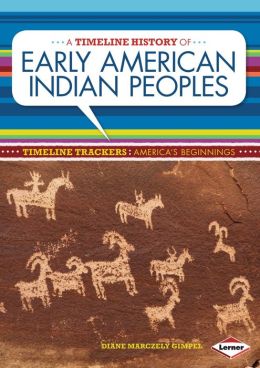
9781467736381
Having grown up with very stereotyped (read: wildly inaccurate) teachings about Native Americans in school, I tend to approach any material about them these days with a great deal of wariness. I don't know enough myself to be sure I will catch any and all mistakes, but there are certain things I do know to look for - assigning the same cultural traits to all of them is a big one. Writing as if they are a part of history, and not a living breathing cultural group today, is another.
With that in mind, I'm not going to claim this is the only review you need to look to on this book, but here is my take on it!
At the very beginning, Gimpel acknowledges that there are different theories as to how the very first humans arrived in North America, and that they didn't exactly keep calendars. A small sidebar also explains the basics of timelines, which many readers may find useful. She also differentiates between native groups and tribes, which I have not seen anyone else do.
For the most part, each two-page spread has text at the top, giving cultural information and explaining events that caused the movement of different groups. At the middle we have both photographs and illustrations, often a side bar with more information. At the bottom is the time line, with a few particular events highlighted. Somehow, this does not seem too crowded or busy, and the whole thing flows remarkably well!
Covering such a huge time span (20,000 BC to almost the present day) and hundreds of separate cultures in 48 pages is not an easy assignment. One can forgive an occasional mistake (psst - in the side bar on page 15, "Pocahontas" is spelled wrong. But, thank-you for not giving the Disney version of who she was!) (Oh, and the Apache didn't just use wickiups, some used tipis - and still do!) I was amazed to find no blatant editorializing of events - the "doctrine of discovery" is explained very matter-of-factly, as are multiple massacres committed by just about everybody.
I'm not sure who the best audience for this would be. Too much info for a single report, but good basic background to lead off an in-depth study of Native American cultures. I think I will hand this to home schoolers who want to do more than the 'obligatory' one-week unit in November.
***Edited because I totally forgot the gift guide! Please. PLEASE. Do not give this with a fake headdress and tomahawk, or something equally 1950's ignorant. Do a little research about local Native American people groups, and plan a trip. Visit Chaco Canyon, or the Serpent Mounds, learn a little history AND show your children that Native Americans a) still exist, and b) dress, learn, talk, live, for the most part, just like them. I highly recommend this series as well:

I'm not sure who the best audience for this would be. Too much info for a single report, but good basic background to lead off an in-depth study of Native American cultures. I think I will hand this to home schoolers who want to do more than the 'obligatory' one-week unit in November.
***Edited because I totally forgot the gift guide! Please. PLEASE. Do not give this with a fake headdress and tomahawk, or something equally 1950's ignorant. Do a little research about local Native American people groups, and plan a trip. Visit Chaco Canyon, or the Serpent Mounds, learn a little history AND show your children that Native Americans a) still exist, and b) dress, learn, talk, live, for the most part, just like them. I highly recommend this series as well:
No comments:
Post a Comment